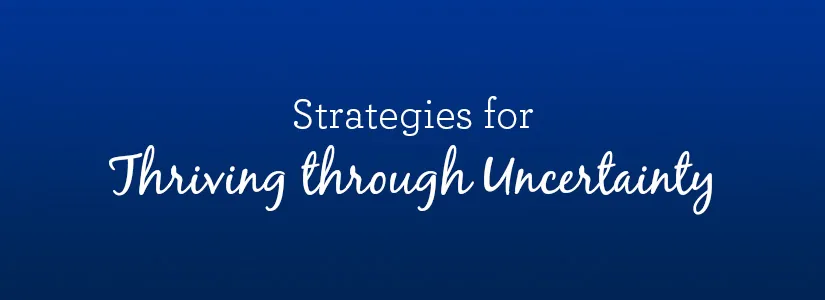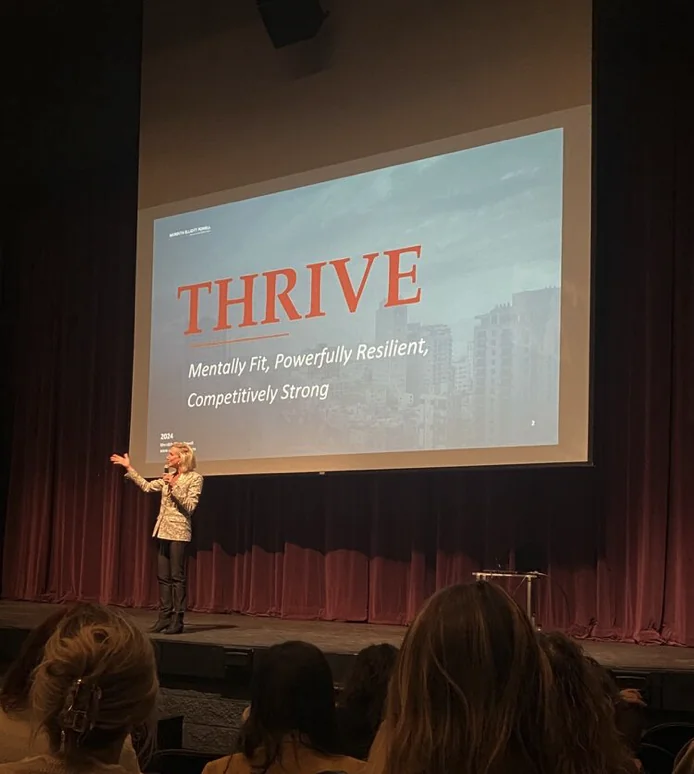
My September article discussed the challenges that uncertainty presents to business leaders’ ability to lead as well as the toll unpredictability inflicts on all of us as—low morale, diminished motivation, and disengagement. Leading through disruption and volatility calls for a different set of leadership skills.
In addition to providing some tactics that help manage those negative effects, I introduced you to Meridith Powell, who developed a formula for transforming uncertainty into opportunity. The Thrive System is based on her extensive research about businesses that have thrived over the last 250 years— through world wars, the Depression, two pandemics, and countless innovations.
Her presentation “Thrive: Mentally Fit, Powerfully Resilient, Competitively Strong” at the Business Leaders Breakfast Forum was an inciteful tutorial on how to help organizations navigate uncertainty, keep them motivated, and spark innovation and creativity to achieve results. Because of the overwhelmingly positive feedback about the value of her presentation, I wanted to share an abbreviated recap, minus the entertaining humor Meridith deftly incorporated to enrapt our audience.

Uncertainty Uptick
The pace of change has accelerated a whopping 183%, according to Accenture—a third faster than a year ago. The toll on employees: 86% surveyed reported they are overwhelmed and/or burned out, feeling that their employers aren’t doing enough to help them navigate their stress and anxiety. The toll on businesses: $300 billion on their bottom line.
These statistics point to the critical need for businesses to lead differently in a marketplace fraught with the uncertainty that fast-paced change produces. How can leaders eliminate the fear that shuts down the creativity, engagement, and motivation that drives down results?
Getting to Mentally Fit, Powerfully Resilient, Competitively Strong
In a nutshell, according to Meridith, these nine strategies “transform uncertainty into your greatest competitive advantage” by making everyone feel ownership of and responsible for the organization’s success. As she walked us through them, it felt incredible to learn how closely these strategies aligned with our key tenants and pillars that create a culture of engagement.
Strategy #1: Relentless vision
Successful leaders have a clearly defined vision that is continuously communicated throughout the organization. The vision focuses on what is possible, not what is logical. Leaders need to share what is possible, so their teams understand why they should do what they’re supposed to be doing.
Illustration: A whitewater rafting guide tried to discourage a group from starting their planned journey due to exceptionally dangerous conditions. When pressed, the guide relented if the group would agree to a training session with a single focus on what is possible: Move to calm water, but beware of obstacle.
Visionaries comprise only 2% of the population; 12% are strategic thinkers; the rest are tactical doers.
Think how Martin Luther King’s visionary “I have a dream” speech ignited the Civil Rights movement’s motivation.
Ask Hillary: Leaders need to keep the team’s eye of the vision ball and make sure the team understands their role in how it’s realized and connected to the entire organization.
Strategy #2: Embrace the suck
This U.S. military mantra imbues soldiers with confidence that they’re going to win in the face of uncertainty. Think of it as cheerleading on steroids, strengthening your organization’s confidence muscle that empowers team members to apply innovation and creativity to overcome obstacles in the way of achieving the relentless vision. A majority of employees (76%) who buy into a leader’s relentless vision will embrace the suck instead of going AWOL.
Illustration: Facing the threat of prohibition, Jacob Beam (yes, the whiskey founder) began investing in mining, growing citrus, and foreign distribution. Unlike his competitors who went bankrupt, Beam had revenue streams while his distillery was closed. He refined the company’s recipe and cultivating his distribution network and 120 days after the repeal of prohibition, Beam was ready to hit the ground running.
Businesses face uncertainties revolving around society, competition, economics, politics, technology, industry, and customers. Leaders should share changes/obstacles they see with their teams and gather their ideas for addressing them. making them feel like they’re part of the solution.
Ask Hillary: Leaders who make their teams feel like they’re part of the solution strengthen engagement and discretionary effort to achieve success.
Strategy #3: Collaborate

Think about collaborating with competitors and non-competitors, even other divisions within your own company. Who could you be working with to solve an existing problem or address uncertainty around change? Increase revenue? Decrease costs?
Illustration: During COVID, many companies had to release or furlough employees. McDonald’s and Aldi, two essential businesses, collaborated to share their employees and avoid letting their people go. Because Aldi had to expand their operations to 24/7, the company needed more employees Because McDonald’s limited operations to their drive-through, the company had a surplus of employees that they loaned to Aldi, with an agreement that when they restored their restaurant service, Aldi would give them back. Everyone won, including the employees who were happy to keep working.
Ask Hillary: Leaders should foster internal collaboration through interactive communications and meetings that uncover ways to streamline processes, reduce costs, and increase revenue.
Strategy #4: Know your core
Make decisions based on core values. What you stand for is a firm foundation for decision-making vs. the fragility of unknown outcomes.
Illustration: Chick-fil-A is the second fastest-growing fast-food restaurant in the country. Founder S. Truett Cathy decided to close on Sundays in 1946 based on his belief in the importance of letting his employees have a day to rest and worship if they choose. He was willing to give up revenue for those 52 days each year. His reward: retention of 97% of franchisees.
Ask Hillary: Keep your organizational values in front of employees by bringing them to life to ensure all decisions and actions are aligned with them.
Strategy #5: Secure your base

Growth comes from the inside out. Stay focused on how to make money by turning customer complaints into gold. Customers control the buying cycle, so listen to what they say isn’t being taken care of in the marketplace and fill that gap.
Illustration: When Proctor & Gamble (P&G) started in the 1800’s, their first product line was candles made from animal fat. Facing a supply chain issue with animal fat, they conducted market research through their sales people and learned that customers complained about how slippery bars of soap got lost in the bathtub. They listened and launched Ivory with the slogan “the soap that floats”.
Your greatest source of intel is your customer base. They’ll tell you how to differentiate and gain market share.
Ask Hillary: Keep customers engaged and demonstrate your appreciation for their business by incorporating their feedback into your business processes and products/services.
Strategy #6: Lead through the power of the question
Information is power, and relationships unlock knowledge. Build connections through networking and mastering the dying art of asking questions. Train all of your people how to do that and they will become conduits for uncovering opportunities to grow business.
Ask Hillary: Asking people about themselves is the best way to make them feel like they matter. Encourage all team members to get involved in community and business activities, and educate them about how to build connections.
Strategy #7: Strengthen your team
People support what they help create. They want to feel they’re making a difference. They need to feel useful. To instill those feelings, be a “transformational” leader who decides the vision and goals, and let them decide how to accomplish them. Teach your team to think and foster their development by asking questions vs. telling them how to do their jobs like a “hero” leader.
Transformational leaders make their people feel heard and valued for their opinions vs. hero leaders who shut down engagement by turning their people into order takers.
Ask Hillary: A strong onboarding program makes employees feel like they matter on day one. Continue strengthening your team by soliciting their opinions, mentoring them, and challenging them to help solve problems. Focus on the 60% of your team who are moldable.
Strategy #8: Shed fast & keep moving
Busy does not necessarily equal productive. To ensure the organization is doing the right things, continually identify positive actions that drive revenue and eliminate actions that are a waste of time. Be nimble in Identifying actions that need to be taken that aren’t currently being taken. Drive clear communications about what’s important throughout the organization.
Ask Hillary: “Waterfall” communications (from the C-suite to department heads, managers, and frontline supervisors) is key to frequently and clearly keeping organizations on track about goals, tactics, and results.
Strategy #9: Rinse & Repeat
Hold on to this mindset and continue to apply these nine strategies to new and changing circumstances for sustainable success.
Ask Hillary: Monitor. Measure. Modify.
Wrap-up

Powell summarized the primary drivers of the Thrive System in three words: preparation, purpose (vision, beyond a job), and people (community, relationships, connections).
Although uncertainty has plagued humanity forever, globalization and technology have magnified its prevalence and impact. The more you can do to help your people navigate uncertainty, the more you will give them hope, keep them motivated, and spark the innovation and creativity needed to achieve results. If you’d like a partner to help you bring the Thrive System’s nine strategies to life, let’s start a conversation.
